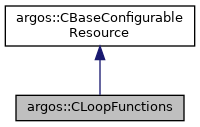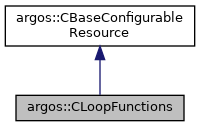A set of hook functions to customize an experimental run. More...
#include <loop_functions.h>


Public Member Functions | |
| CLoopFunctions () | |
| Class constructor. More... | |
| virtual | ~CLoopFunctions () |
| Class destructor. More... | |
| virtual void | Init (TConfigurationNode &t_tree) |
| Executes user-defined initialization logic. More... | |
| virtual void | Reset () |
| Executes user-defined reset logic. More... | |
| virtual void | Destroy () |
| Executes user-defined destruction logic. More... | |
| virtual void | PreStep () |
| Executes user-defined logic right before a control step is executed. More... | |
| virtual void | PostStep () |
| Executes user-defined logic right after a control step is executed. More... | |
| virtual bool | IsExperimentFinished () |
Returns true if the experiment is finished. More... | |
| virtual void | PostExperiment () |
| Executes user-defined logic when the experiment finishes. More... | |
| virtual CColor | GetFloorColor (const CVector2 &c_pos_on_floor) |
| Returns the color of the floor in the specified point. More... | |
| CSimulator & | GetSimulator () |
| Returns the simulator instance. More... | |
| CSpace & | GetSpace () |
| Returns a reference to the space state. More... | |
| const CSpace & | GetSpace () const |
| virtual void | MoveEntity (CPositionalEntity &c_entity, const CVector3 &c_position, const CQuaternion &c_orientation) |
| Moves the entity to the wanted position and orientation. More... | |
| virtual bool | MoveEntity (CEmbodiedEntity &c_entity, const CVector3 &c_position, const CQuaternion &c_orientation, bool b_check_only=false, bool b_ignore_collisions=false) |
| Moves the entity to the wanted position and orientation. More... | |
| virtual void | AddEntity (CEntity &c_entity) |
| Adds the passed entity to the simulation. More... | |
| virtual void | RemoveEntity (const std::string &str_entity_id) |
| Removes an entity from the simulation. More... | |
| virtual void | RemoveEntity (CEntity &c_entity) |
| Removes an entity from the simulation. More... | |
| void | IterateOverControllableEntities (const CSpace::TControllableEntityIterCBType &c_cb) const |
| Iterate over all controllable entities currently present in the arena (including those that are currently disabled) executing the specified callback on each. More... | |
 Public Member Functions inherited from argos::CBaseConfigurableResource Public Member Functions inherited from argos::CBaseConfigurableResource | |
| virtual | ~CBaseConfigurableResource () |
| Class destructor. More... | |
Detailed Description
A set of hook functions to customize an experimental run.
It is very difficult to identify a set of features that can cover all the possible use cases of multi-robot systems. Even though some features, such as robot motion, are almost always necessary, many other features depend on the type of experiment considered. For instance, the metrics against which statistics must be calculated depend on the experiment. Also, if the environment presents custom dynamics, such as objects being added or removed as a result of the actions of the robots, these mechanisms need to be implemented in the simulator. The need for specific and often divergent features renders the design of a generic simulator extremely complex. Furthermore, the approach of trying to add a myriad of features in the attempt to cover every possible use case usually renders the learning curve of a tool much steeper, hindering usability and maintainability.
To cope with these issues, we followed the common approach of providing user-defined function hooks in strategic points of the simulation loop. In ARGoS, these hooks are called loop functions. The user can customize the initialization and the end of an experiment, and add custom functionality executed before and/or after each simulation step. It is also possible to define custom end conditions for an experiment.
Loop functions allow one to access and modify the entire simulation. In this way, the user can collect figures and statistics, and store complex data for later analysis. It is also possible to interact with the simulation by moving, adding or removing entities in the environment, or by changing their internal state.
Finally, loop functions can be used to prototype new features before they are promoted to the core ARGoS code.
Definition at line 70 of file loop_functions.h.
Constructor & Destructor Documentation
◆ CLoopFunctions()
|
inline |
Class constructor.
Definition at line 77 of file loop_functions.h.
◆ ~CLoopFunctions()
|
inlinevirtual |
Class destructor.
Definition at line 85 of file loop_functions.h.
Member Function Documentation
◆ AddEntity()
|
virtual |
Adds the passed entity to the simulation.
Important: the entity must be created with a new statement or a CFactory::New() statement. In other words, the entity must be stored in the heap. If this is not the case, memory corruption will occur.
- Parameters
-
c_entity A reference to the entity to add.
- Exceptions
-
CARGoSException if an error occurs.
Definition at line 37 of file loop_functions.cpp.
◆ Destroy()
|
inlinevirtual |
Executes user-defined destruction logic.
This method should undo whatever is done in Init(). The default implementation of this method does nothing.
- See also
- Init()
Implements argos::CBaseConfigurableResource.
Definition at line 111 of file loop_functions.h.
◆ GetFloorColor()
|
inlinevirtual |
Returns the color of the floor in the specified point.
This function is called if the floor entity was configured to take the loop functions as source. The floor color is used by the ground sensors to calculate their readings, and by the graphical visualization to create a texture to display on the arena floor.
- Parameters
-
c_pos_on_floor The position on the floor.
- Returns
- The color of the floor in the specified point.
Definition at line 165 of file loop_functions.h.
◆ GetSimulator()
|
inline |
Returns the simulator instance.
- Returns
- The simulator instance.
Definition at line 173 of file loop_functions.h.
◆ GetSpace() [1/2]
|
inline |
Returns a reference to the space state.
- Returns
- A reference to the space state.
Definition at line 181 of file loop_functions.h.
◆ GetSpace() [2/2]
|
inline |
Definition at line 185 of file loop_functions.h.
◆ Init()
|
inlinevirtual |
Executes user-defined initialization logic.
The default implementation of this method does nothing.
- Parameters
-
t_tree The <loop_functions>XML configuration tree.
Implements argos::CBaseConfigurableResource.
Definition at line 94 of file loop_functions.h.
◆ IsExperimentFinished()
|
inlinevirtual |
Returns true if the experiment is finished.
This method allows the user to specify experiment-specific ending conditions. The default implementation of this method returns always false. This means that the only ending conditions for an experiment are time limit expiration or GUI shutdown.
- Returns
trueif the experiment is finished.
Definition at line 138 of file loop_functions.h.
◆ IterateOverControllableEntities()
|
inline |
Iterate over all controllable entities currently present in the arena (including those that are currently disabled) executing the specified callback on each.
The specified callback can be executed in a multi-threaded context, depending on configuration (i.e. how many threads were specified in the input file) improving simulation efficiency by re-using ARGoS threads rather than the loop functions having to create/maintain its own thread pool(s). If multiple ARGoS threads are specified, the following operations CANNOT be safely performed on the entity passed to each callback:
- Entity removal
- Creating a new entity based on the current one
Furthermore, iteration over controllable entities can be performed AT MOST twice in one timestep: one time in PreStep(), and one time in PostStep(). Mutiple iteration attempts in either function will cause a deadlock due to how iteration is implemented.
- See also
- PostStep()
- PreStep()
Definition at line 264 of file loop_functions.h.
◆ MoveEntity() [1/2]
|
virtual |
Moves the entity to the wanted position and orientation.
The movement is allowed only if the object does not collide with anything once in the new position.
- Parameters
-
c_entity The positional or embodied component of the entity to move. c_position The wanted position. c_orientation The wanted orientation. b_check_only If false, the movement is executed; otherwise, the object is not actually moved.b_ignore_collisions If false, collisions are considered; iftrue, collisions are ignored
- Returns
trueif no collisions were detected,falseotherwise.
Definition at line 26 of file loop_functions.cpp.
◆ MoveEntity() [2/2]
|
virtual |
Moves the entity to the wanted position and orientation.
- Parameters
-
c_entity The positional component of the entity to move. c_position The wanted position. c_orientation The wanted orientation.
Definition at line 17 of file loop_functions.cpp.
◆ PostExperiment()
|
inlinevirtual |
Executes user-defined logic when the experiment finishes.
This method is called within CSimulator::IsExperimentFinished() as soon as its return value evaluates to true. This method is executed before Destroy(). You can use this method to perform final calculations at the end of an experiment. The default implementation of this method does nothing.
Definition at line 151 of file loop_functions.h.
◆ PostStep()
|
inlinevirtual |
Executes user-defined logic right after a control step is executed.
This function is executed before the actuators are updated for the next time step. The default implementation of this method does nothing.
- See also
- PreStep()
Definition at line 127 of file loop_functions.h.
◆ PreStep()
|
inlinevirtual |
Executes user-defined logic right before a control step is executed.
This function is executed before the sensors are updated for the current time step. The default implementation of this method does nothing.
- See also
- PostStep()
Definition at line 119 of file loop_functions.h.
◆ RemoveEntity() [1/2]
|
virtual |
Removes an entity from the simulation.
- Parameters
-
c_entity A reference to the entity to remove.
Definition at line 52 of file loop_functions.cpp.
◆ RemoveEntity() [2/2]
|
virtual |
Removes an entity from the simulation.
- Parameters
-
str_entity_id The id of the entity to remove.
- Exceptions
-
CARGoSException If an entity with the specified id was not found.
Definition at line 44 of file loop_functions.cpp.
◆ Reset()
|
inlinevirtual |
Executes user-defined reset logic.
This method should restore the state of the simulation at it was right after Init() was called. The default implementation of this method does nothing.
- See also
- Init()
Implements argos::CBaseConfigurableResource.
Definition at line 103 of file loop_functions.h.